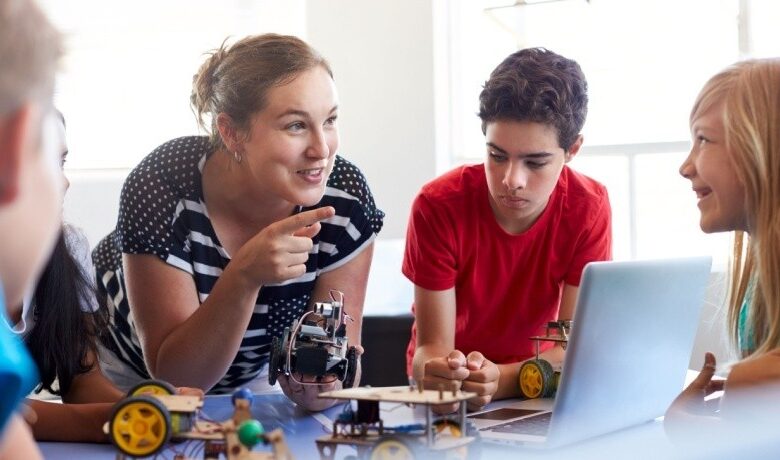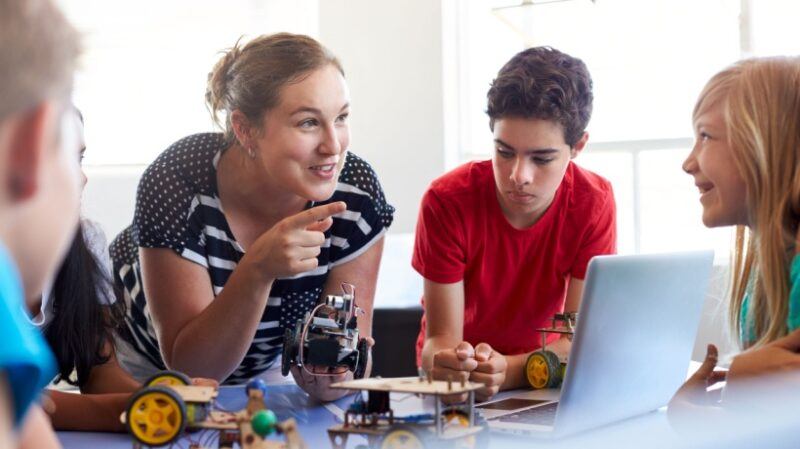STEM Vs. STEAM: Differences, Benefits, And Implementation Tips


The Main Differences Between STEM And STEAM
STEM and STEAM have a very different way of approaching scientific matters, with the first focusing solely on hard skills. It concentrates on enriching learners with practical skills in technology, science, mathematics, and engineering. While STEAM also teaches the same fundamentals and focuses on the same concepts, it utilizes art and a combination of hard and soft skills as well. It allows the use of creativity and imagination to understand complex subjects while letting learners with a powerful creative side flourish and follow their passions. For instance, fine art imagery and 3D models may be enforced to aid comprehension, with students being given the freedom to innovate without following strict instructions. However, none of the two teaching styles have a clear definition since teachers can choose different implementation methods.
What Is STEM?
Previously known as SMET, STEM stands for science, technology, engineering, and mathematics. While there is no set definition, the learning method focuses on teaching students these four fundamentals that prepare them for the future and for succeeding in the career paths they choose to follow. The skills it offers are necessary for increasing innovation and creating technological advancements. There is no clear implementation method, as some teachers think that social and political sciences also belong in the field, while others believe that traditional fields like biology and chemistry deserve a spot.
What Is STEAM?
STEM and STEAM are based on the same foundation, with the important addition of the arts. Employers nowadays value soft skills equally, if not more than hard skills, and, therefore, creativity and innovation must be cultivated. Integrating various forms of art, including dance, drama, music, visual arts, and design, into educational curricula helps learners and future job holders make themselves competitive. Basically, STEAM focuses on how people communicate and express STEM-related matters while thinking outside the box to solve complex issues. Within institutions, this learning approach allows students to communicate and solve problems collaboratively.
The Benefits Of Combining STEM And STEAM In Education
Innovation, Creativity, And Curiosity
Sometimes, technical knowledge isn’t enough to solve intricate matters, and creative thinking is necessary. STEAM offers the tools to increase learners’ creativity, innovation, and critical thinking. Students are encouraged to experiment by observing, analyzing, and solving complicated subjects. Therefore, they never settle for what they already know and keep asking questions to discover new methods and solutions. By allowing their minds to open wider and perceive new concepts and information, learners come up with unique ideas that polish their problem-solving abilities.
Collaboration And Communication
STEM and STEAM both care about developing practical knowledge on fundamental subjects. However, the latter also encourages collaboration and the exchange of ideas and opinions. Therefore, students learn how to foster healthy interpersonal relationships and work harmoniously to tackle the task at hand. To succeed in their efforts, students must have empathy, which allows them to listen actively and respect their peers’ thoughts. Also, they learn to receive feedback and not be offended. Teachers analyze their pupils’ behavior and intervene whenever necessary. This results in adults who are ready to work in a broad range of fields and take on leadership roles.
Confidence And Acceptance Of Failure
Many people experience failures before succeeding in their field and reaching their goals. The combination of STEM and STEAM teaches students to never stop trying out different solutions until they locate the right one. Until that happens, though, they may face multiple failures and moments of doubt. Through resilience, they overcome their hurdles and keep on pushing. They learn to trust themselves and have confidence in their strengths.
Computational Skills And Real-World Applications
In most traditional educational functions, students are taught various theoretical concepts without putting their knowledge into practice. When STEM and STEAM merge, learners are exposed to real equipment and scientific instruments. For example, they may learn how to use computer-aided design (CAD) to build a product from scratch. They may also receive programming training so they can put their technological knowledge into practice. There are many curriculum solutions for teachers to utilize practical training and encourage students to use their skills critically. Exposure to multimedia increases the media literacy of students and prepares them for real-world cases where they must enforce their theoretical knowledge and act based on it.
Cultural Competence
In the real world, people often collaborate and communicate with peers from different cultural backgrounds. The gaps, however small or big, can be bridged when students learn to respect one another from a young age. Through STEAM, pupils are grouped with peers from various cultures and communicate to solve complex matters. They learn more about their backgrounds and their unique needs. Additionally, teachers may introduce projects that focus on finding solutions for problems impeding a very specific population. Therefore, students must research this population’s unique characteristics and find the most appropriate solution.
How Can Institutions Merge STEM And STEAM?
Sometimes heavily theoretical science-based curricula fail to encourage creativity amongst learners, but they forget that most innovations and advancements happen when people’s brains are left free to imagine and create. So, how can institutions include the arts in their STEM methods? The first way is through design. Students who work on creating a product may start implementing computer graphics to make logos and improve the appearance and usability of their items. Also, design is closely related to mathematics and engineering. For example, ancient paintings and the Great Pyramids of Egypt followed quite accurately the golden ratio. Moreover, STEAM offers advanced communication, with students encouraged to share their ideas, ask questions, and receive feedback. For instance, they may sketch an idea to make it comprehensible to their peers. As a result, the class engages in playful and productive conversations where solutions are generated, and problems are overcome. Students enforce their critical thinking whenever necessary and are enthused to attend school every day.
Conclusion
STEM and STEAM are not opponents fighting for the win but equally productive learning tools that, if merged, can prepare students for the 21st-century workplace. While hard skills are mandatory, soft skills are also crucial in today’s society, and the arts can instill virtues like communication, empathy, and leadership. These skills can’t be duplicated, automated, or taken away from humans, no matter how much technology progresses. That’s why combining the two methods can propel people toward a new reality where complex technological questions arise every single day, and every field has an urgency to move forward.
Source link



